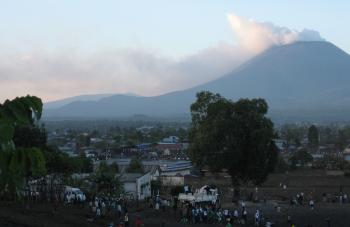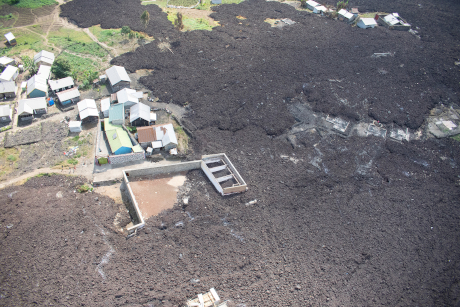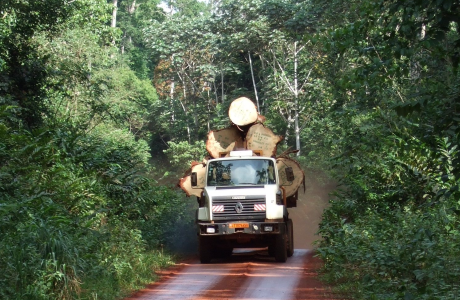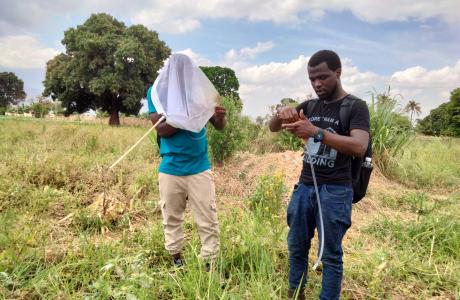Africa's most dangerous volcano can erupt without clear warning signals
On 22 May 2021, the Nyiragongo volcano (DR Congo) erupted. Lava flows destroyed part of the city of Goma and thousands of people fled. In a study published in Nature, an international team of researchers shows that this eruption could not be predicted.

An eruption that caused panic
Goma on 22 May 2021. Shortly before 7pm, residents of this city of one million inhabitants in the east of the Democratic Republic of Congo sounded the alarm. They witnessed the appearance of a lava flow from a fracture on the side of the Nyiragongo volcano.
The eruption took everyone by surprise, and confusion and lack of foresight complicated the management of the first few hours of the crisis. As the lava flow devastated a densely populated area, intense seismic activity began, persisting for several days, causing damage to the border towns of Goma (DRC) and Gisenyi (Rwanda), adding to the panic, and causing the spontaneous evacuation of some of the population.
The eruption lasted only a few hours; the lava flows caused damage, but on a much smaller scale than during the last eruption in 2002, when almost 10% of the city was destroyed.
An atypical eruption
‘Volcanic eruptions are usually preceded by a rise in pressure in the magma supply system, marked by seismicity, an increase in gas emissions and a swelling of the volcanic edifice’, explains Delphine Smittarello, researcher at the European Centre for Geodynamics and Seismology in Luxembourg. ‘To warn of an imminent eruption, volcanological observatories generally monitor seismicity, ground deformation and gaseous emissions reflecting the movement of magma in the Earth's crust.’
‘This Nyiragongo eruption was not preceded by any of these usual precursor signals, despite continuous monitoring by networks of ground-based instruments and satellite sensors. In hindsight, seismic records showed that the first events marking unusual activity started less than 40 minutes before the first lava flows. This very short delay between the first earthquakes and the eruption tells us that the magma needed very little time to reach the surface because it was already stored at a shallow depth’, says the researcher.
Adalbert Muhindo, director of the Goma Volcanological Observatory (OVG), added: ‘This is the first time that such a seismic sequence has been recorded by a local network of sensors during an eruption of Nyiragongo. The detection of signals that occur only very shortly before the eruption provides important new knowledge to be incorporated into future monitoring methods for this volcano by our observatory in Goma, but also potentially for other volcanoes around the world with large amounts of magma stored near the surface.’
‘This behaviour of the volcano was all the more unexpected as the only two known historical eruptions, in 1977 and 2002, were preceded by strong earthquakes (M>5) felt a few weeks to a few days beforehand.’

New threats?
The study also shows that a large volume of magma (243 million m³) moved under the city of Goma. ‘This magma spread rapidly at a shallow depth (less than 500 m from the surface) from the volcano southwards, passing under the town of Goma, and finally stopping under Lake Kivu’, explains Benoît Smets, researcher at the Royal Museum for Central Africa and Nyiragongo specialist.
This magma behaviour presents new threats related to Nyiragongo, according to Benoît Smets: ‘Our results suggest that, whenever magma flows at such a shallow depth, there is a risk of lava effusion right in the middle of the city, of phreatomagmatic eruption (if the magma comes into contact with the cold water of Lake Kivu) or even of limnic eruption of Lake Kivu, which is feared because of the enormous quantity of CO2 and methane dissolved in its deep waters. These events are potentially much more dangerous than the three eruptions known so far.’
This study is part of a collaboration of more than 15 years between the Goma Volcanological Observatory (DR Congo), the Royal Museum for Central Africa (Belgium), the European Center for Geodynamics and Seismology (Luxembourg), and the National Museum of Natural History (Luxembourg). The collaboration focused, among other things, on developing tools to improve monitoring capabilities.
Smittarello, D. et al. Precursor-free eruption triggered by edifice rupture at Nyiragongo volcano. Nature (2022). https://doi.org/10.1038/s41586-022-05047-8


